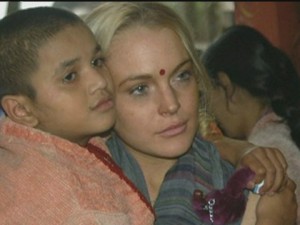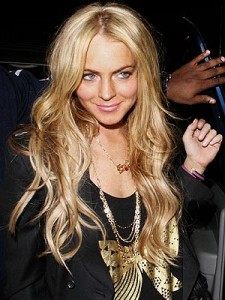It’s well known that fame and stardom attract attention. So it’s not surprising that many aid organisations utilise celebrity to promote their cause. Gerry Halliwell as UN Ambassador, Geldof’s Live Aid, U2 and friends on Amnesty’s Conspiracy Of Hope tour in 1986 (more about St. Bono later) – and more recently… Lindsay Lohan travelling to India to film an expose of child labour and trafficking of women – which broadcast in April ’10 on BBC3.
The following account was provided by the Guardian, U.K. It refers to a section of the documentary where Lohan talks to a child who’s been sold into slavery…
“The shaven-haired girl is explaining that her parents would beat her unless she went out every day to earn money, but it’s hard to concentrate on what she’s saying because what’s happening behind her is so distracting. Lohan is rubbing her already-red eyes, spreading mascara around the place, twitching her eyebrows.”

“Um. Um. Oh my God,” the film star says, her lips wobbling uncontrollably.
A disembodied hand pops into the screen to pass her a tissue.
“Um. How did she feel? Um. How did they treat her?” she asks, beginning to sob.
The small girl turns to look at her in bemusement. The translator gives an embarrassed laugh and says to the girl: “She’s crying for you. Why don’t you comfort her?”
So we watch as the puzzled child dutifully strokes Lohan’s long mane of golden hair.
“Oh my God! Oh my God!” Lohan says, with a husky gasp.
“Sorry, I’m having a moment.
” Mercifully, the camera is then switched off.”
Actually – it was quite a well made documentary. The narration was a bit fast for my taste – but on the whole I agree with the Guardian’s review… “The material is potent and persuasive, and it’s a great film except for the constant, distracting presence of Lohan, whose teary face keeps hoving into view, muttering horrified “wows”.
The story continued when Lohan provoked a row claiming she’d personally rescued 40 children.
“In a series of updates on the social networking site Twitter, she boasted of her role in a daring raid on a child labour sweatshop and claimed the experience had changed her life.”

“But according to activists leading the raids, Ms Lohan did not arrive in India until after the raids had been completed and the children had been rescued. Activists involved in the raids criticised her comments and accused her of trivialising the issue of child trafficking. Now she may not be able to visit India again after officials looked at her case and found she had failed to apply for a work visa for her trip. Senior civil servants in New Delhi are now studying the case and will rule on whether her name will be added to an immigration blacklist.”
It’s all got a bit out of hand. I think celebrity “endorsement” is totally justified if it means bringing attention to an important subject. How many fresh eyes watched the Lohan documentary – who otherwise would have been oblivious to such a serious issue? I remember hearing a great podcast about vaccine centres from United Nations Radio which featured David Beckham in Africa – where, of course, they worship football…
He carries immense respect throughout the continent
and does an excellent job as a UN Ambassador.
So it can be done well…
While we’re on the subject of promoting charities… It’s certainly true that endorsements often work both ways. Gervais’s “Comic Relief” sketch on celebrities who use aid work to gain publicity remains priceless.
Back to the Lohan storm in a teacup… Here’s what the beeb had to say in their defence;
“Justifying its unexpected decision to hire Lohan (better known for what is euphemistically termed a party lifestyle) to front the documentary, the BBC argues that this is about creating a wider interest in poverty and development issues, and it’s true that her involvement has whipped up a lot of pre-broadcast publicity. It is also true that most of this interest has focused on her, not on the issues, and has been wholly negative.”
TBC
« Ethiopian Pharmaceutical / Health Billboards The use of celebrity to promote aid: Part Two, Craig David »
